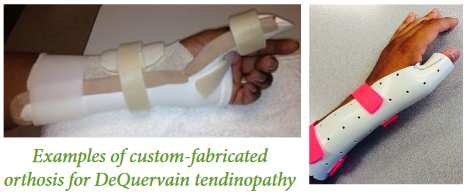|
BOOK NOW |
ASK ABOUT YOUR PAIN |
Home > Blog > Hand Therapy & Customized Splinting > Finger, Hand, Wrist, Forearm & Elbow Conditions > DeQuervain Tendinopathy Hand Therapy
DeQuervain Tendinopathy Hand Therapy
“Working with a knowledgeable hand therapist can make the difference between success and failure in complex hand surgical cases. The therapist extends the continuum of our care, as well as functioning as coach and trainer for our patients.”
Marybeth Ezaki, MD, Past President, American Society for Surgery of the Hand
In Phoenix Rehab, our senior hand therapists are experienced licensed and dedicated therapists (physiotherapists and/or occupational therapists) who specialized ONLY in the rehabilitation, treatment and management of painful fingers, hands, wrists, forearm & elbow conditions, because of interest, passion and expertise.

DeQuervain tendinopathy involves the tendons that run along the thumb side of the wrist.
These tendons anchor muscle to bone, and the tendons associated with this condition help to pull the thumb out and away from the palm.
These tendons travel under a “tunnel,” known as the first dorsal compartment, as they approach the base of the thumb. The patient will typically notice aching or sharp pain in this area as wrist and thumb motions move the tendons back and forth under the tunnel.
What are the symptoms of DeQuervain tendinopathy?
Most of the time, pain will be noted along the thumb side of the wrist, and can extend down the thumb or up the forearm. Patients will complain of pain when reaching across the palm with the thumb, pinching or with movements of the wrist.
A twisting motion, such as wringing out a washcloth, can also create pain.
What causes DeQuervain tendinopathy?
DeQuervain tendinopathy, also known as DeQuervain tendonitis or DeQuervain tenosynovitis, is thought to be from thickening and narrowing of the first compartment tunnel, or may occur because of inflammation or degeneration of the tendons of the first compartment.
This restricts the thumb tendons from gliding freely and smoothly through the tunnel.
It can be associated with overuse, or in some situations...it may develop for no apparent reason.
Often new mothers will develop DeQuervain tendinopathy, thought to be caused by swelling and hormonal changes that occur with pregnancy and delivery, as well as the activities associated with mothering eg
- lifting and putting baby down
- feeding
- changing
- showering
What is the treatment for DeQuervain tendinopathy?
Treatment for DeQuervain’s can be surgical or conservative (non-operative).
Conservative treatments your doctor might recommend include anti-inflammatory medications or a steroid injection into the painful area as well as provide a referral to our senior hand therapists for evaluation and hand therapy.
Surgical intervention might be recommended for severe symptoms lasting six months or longer that's persistent, unresolved or chronic.
Surgery involves an incision to open up the first compartment tunnel to restore smooth gliding of the thumb tendons (termed as a "release").
Fortunately, most patients do not need surgery and can be successfully treated conservatively.
What can a hand therapist do for me?
Our senior hand therapists can provide conservative treatment for DeQuervain tendinopathy.
We help the patient determine which activities aggravate the symptoms and help with activity modification. We may recommend a custom-fabricated orthosis, for the wrist and thumb to provide rest for the injured tissues.
Following surgery, hand therapy is important to restore range of motion and return the patient to full activity.

Patients may also receive the following hand therapy treatment modalities:
- cold therapy
- heat therapy
- moist heat paraffin wax therapy
- manual therapy
- joint mobilization
- ultrasound therapy
- etc